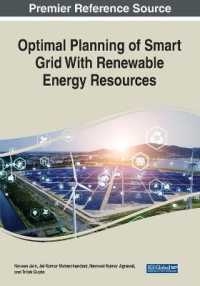- ホーム
- > 洋書
- > 英文書
- > Transportation
Full Description
Transport is responsible for a growing share of global energy consumption and greenhouse gas emissions, emerging as an economic sector for which technical solutions have shown limited benefits and a shift to electric mobility is seen as an essential part of tackling both problems. However, despite electric motive power being older technology than internal combustion engines and having many advantages, both inherent disadvantages and the inertia of not being the dominant road transport technology mean that it is only recently that electric vehicles (EVs) have attracted serious policy attention.
Electrifying Mobility: Realising a Sustainable Future for the Car examines the basis of this electric mobility 'turn', considering the drivers, barriers to adoption and the current lived experience of EV use, drawing upon this experience to inform planning for mass EV adoption and how regulation might change to reflect the specific needs and challenges raised. Considering future transport policy, practice, and management where EVs become an important part of the road transport fleet, and, it is assumed, eventually come to dominate it, chapters study how EV and Connected and Autonomous Vehicle (CAV) technologies relate, and whether there are synergies with shared mobility.
The Transport and Sustainability series addresses the important nexus between transport and sustainability containing volumes dealing with a wide range of issues relating to transport, its impact in economic, social, and environmental spheres, and its interaction with other policy sectors.
Contents
Part 1: The Political-Economic Context and Environmental Imperative
Chapter 1. Introduction: The Electrification of Automobility; Graham Parkhurst
Chapter 2. Easy Street for Low-Carbon Mobility? The Political Economy of Mass Electric Car Adoption; Cameron Roberts
Chapter 3. The Energy and Emissions Case and The Lifecycle Impact of Electric Cars; Eckard Helmers
Part 2: Overcoming Inertia: From Internal Combustion Engine to Electric Car
Chapter 4. Producing the Electric Car; Peter Wells and Jean-Paul Skeete
Chapter 5. Making the Market: The Transformation Pathway to Electric Car Mobility in The Netherlands; Marc Dijk
Chapter 6. Choosing the Electric Car; Colin Whittle and Lorraine Whitmarsh
Part 3: Living with the Electric Car
Chapter 7. The Effect of Electric Car Adoption on Travel Patterns; Craig Morton
Chapter 8. Becoming an Electric Car Owner: User Experience and the EV Community; William Clayton
Chapter 9. Planning for Electric Car Charging: A Review of Technologies, Criteria and Methods; Stefania Boglietti, Martina Carra, Massimiliano Sotgiu, Benedetto Barabino, Michela Bonera, and Giulio Maternini
Part 4: Electric Cars in the Future
Chapter 10. Electric Cars: The Future Technological Potential; Javier Turienzo, Jesús F. Lampón, Roberto Chico-Tat, and Pablo Cabanelas
Chapter 11. Americans' Plans for Acquiring and Using Electric, Shared and Self-Driving Cars; Neil Quarles, Kara M. Kockelman, and Jooyong Lee
Chapter 12. Conclusion: The Electric Car as a Component of Future Sustainable Mobility; Graham Parkhurst and William Clayton





